NUR241 - Premenstrual Syndrome Case Study: Challenge and Response
VerifiedAdded on 2023/06/07
|7
|1704
|169
Case Study
AI Summary
This case study delves into Premenstrual Syndrome (PMS) through the experiences of Tracey Wilson, a 38-year-old businesswoman presenting with symptoms like anger, irritability, breast tenderness, and food cravings. The assignment addresses the causes and symptoms of PMS and premenstrual dysphoric disorder, differentiating them from Polycystic Ovary Syndrome (PCOS). It explores potential causes, including hormonal imbalances and neurotransmitter involvement, and discusses various therapeutic interventions such as lifestyle modifications, NSAIDs, antidepressants, and diuretics. The study references current research to support its analysis of PMS and its management, providing a comprehensive overview of the condition and its impact on women's health. This document is available on Desklib, a platform offering a wealth of study resources including past papers and solved assignments.
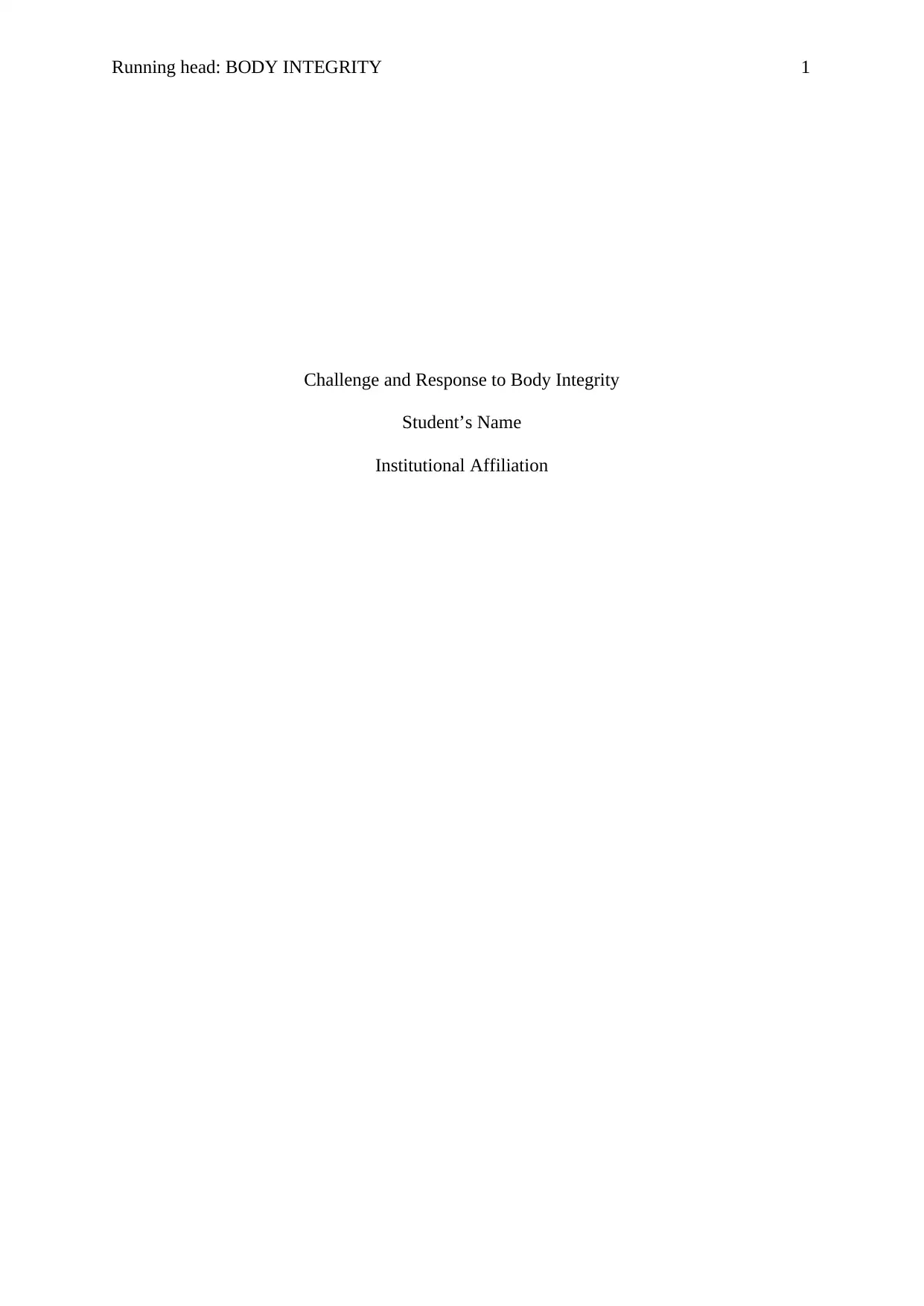
Running head: BODY INTEGRITY 1
Challenge and Response to Body Integrity
Student’s Name
Institutional Affiliation
Challenge and Response to Body Integrity
Student’s Name
Institutional Affiliation
Secure Best Marks with AI Grader
Need help grading? Try our AI Grader for instant feedback on your assignments.
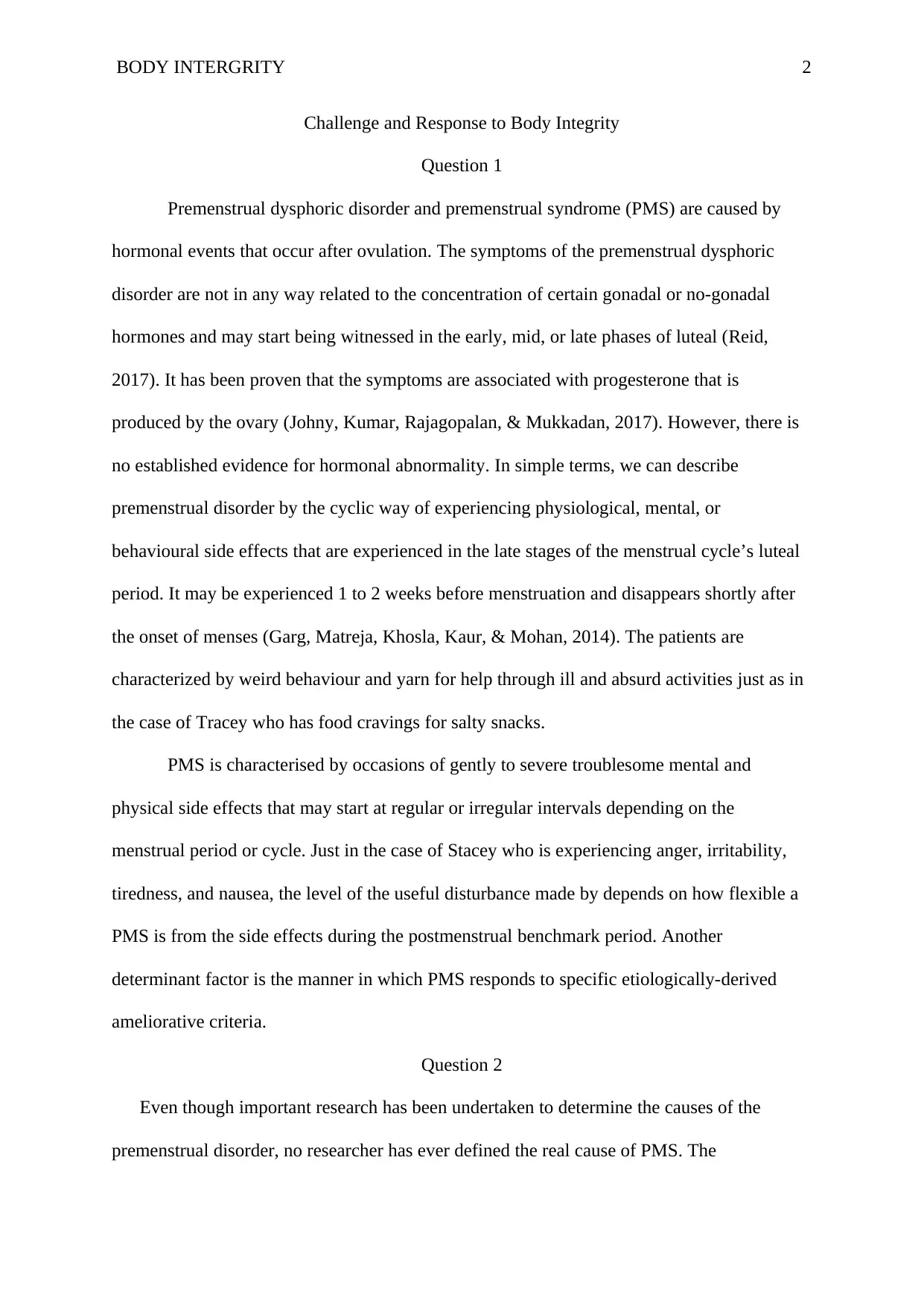
BODY INTERGRITY 2
Challenge and Response to Body Integrity
Question 1
Premenstrual dysphoric disorder and premenstrual syndrome (PMS) are caused by
hormonal events that occur after ovulation. The symptoms of the premenstrual dysphoric
disorder are not in any way related to the concentration of certain gonadal or no-gonadal
hormones and may start being witnessed in the early, mid, or late phases of luteal (Reid,
2017). It has been proven that the symptoms are associated with progesterone that is
produced by the ovary (Johny, Kumar, Rajagopalan, & Mukkadan, 2017). However, there is
no established evidence for hormonal abnormality. In simple terms, we can describe
premenstrual disorder by the cyclic way of experiencing physiological, mental, or
behavioural side effects that are experienced in the late stages of the menstrual cycle’s luteal
period. It may be experienced 1 to 2 weeks before menstruation and disappears shortly after
the onset of menses (Garg, Matreja, Khosla, Kaur, & Mohan, 2014). The patients are
characterized by weird behaviour and yarn for help through ill and absurd activities just as in
the case of Tracey who has food cravings for salty snacks.
PMS is characterised by occasions of gently to severe troublesome mental and
physical side effects that may start at regular or irregular intervals depending on the
menstrual period or cycle. Just in the case of Stacey who is experiencing anger, irritability,
tiredness, and nausea, the level of the useful disturbance made by depends on how flexible a
PMS is from the side effects during the postmenstrual benchmark period. Another
determinant factor is the manner in which PMS responds to specific etiologically-derived
ameliorative criteria.
Question 2
Even though important research has been undertaken to determine the causes of the
premenstrual disorder, no researcher has ever defined the real cause of PMS. The
Challenge and Response to Body Integrity
Question 1
Premenstrual dysphoric disorder and premenstrual syndrome (PMS) are caused by
hormonal events that occur after ovulation. The symptoms of the premenstrual dysphoric
disorder are not in any way related to the concentration of certain gonadal or no-gonadal
hormones and may start being witnessed in the early, mid, or late phases of luteal (Reid,
2017). It has been proven that the symptoms are associated with progesterone that is
produced by the ovary (Johny, Kumar, Rajagopalan, & Mukkadan, 2017). However, there is
no established evidence for hormonal abnormality. In simple terms, we can describe
premenstrual disorder by the cyclic way of experiencing physiological, mental, or
behavioural side effects that are experienced in the late stages of the menstrual cycle’s luteal
period. It may be experienced 1 to 2 weeks before menstruation and disappears shortly after
the onset of menses (Garg, Matreja, Khosla, Kaur, & Mohan, 2014). The patients are
characterized by weird behaviour and yarn for help through ill and absurd activities just as in
the case of Tracey who has food cravings for salty snacks.
PMS is characterised by occasions of gently to severe troublesome mental and
physical side effects that may start at regular or irregular intervals depending on the
menstrual period or cycle. Just in the case of Stacey who is experiencing anger, irritability,
tiredness, and nausea, the level of the useful disturbance made by depends on how flexible a
PMS is from the side effects during the postmenstrual benchmark period. Another
determinant factor is the manner in which PMS responds to specific etiologically-derived
ameliorative criteria.
Question 2
Even though important research has been undertaken to determine the causes of the
premenstrual disorder, no researcher has ever defined the real cause of PMS. The
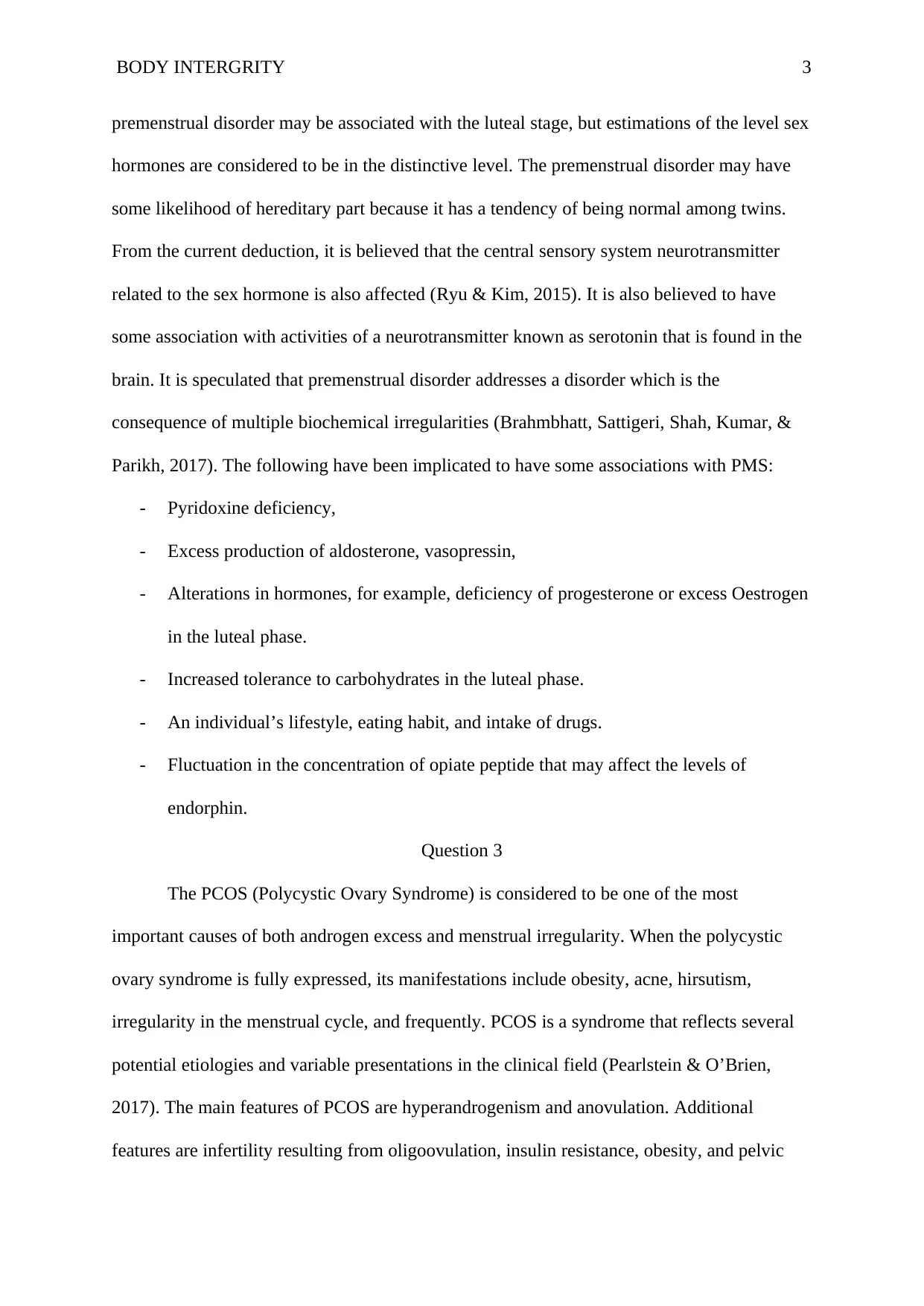
BODY INTERGRITY 3
premenstrual disorder may be associated with the luteal stage, but estimations of the level sex
hormones are considered to be in the distinctive level. The premenstrual disorder may have
some likelihood of hereditary part because it has a tendency of being normal among twins.
From the current deduction, it is believed that the central sensory system neurotransmitter
related to the sex hormone is also affected (Ryu & Kim, 2015). It is also believed to have
some association with activities of a neurotransmitter known as serotonin that is found in the
brain. It is speculated that premenstrual disorder addresses a disorder which is the
consequence of multiple biochemical irregularities (Brahmbhatt, Sattigeri, Shah, Kumar, &
Parikh, 2017). The following have been implicated to have some associations with PMS:
- Pyridoxine deficiency,
- Excess production of aldosterone, vasopressin,
- Alterations in hormones, for example, deficiency of progesterone or excess Oestrogen
in the luteal phase.
- Increased tolerance to carbohydrates in the luteal phase.
- An individual’s lifestyle, eating habit, and intake of drugs.
- Fluctuation in the concentration of opiate peptide that may affect the levels of
endorphin.
Question 3
The PCOS (Polycystic Ovary Syndrome) is considered to be one of the most
important causes of both androgen excess and menstrual irregularity. When the polycystic
ovary syndrome is fully expressed, its manifestations include obesity, acne, hirsutism,
irregularity in the menstrual cycle, and frequently. PCOS is a syndrome that reflects several
potential etiologies and variable presentations in the clinical field (Pearlstein & O’Brien,
2017). The main features of PCOS are hyperandrogenism and anovulation. Additional
features are infertility resulting from oligoovulation, insulin resistance, obesity, and pelvic
premenstrual disorder may be associated with the luteal stage, but estimations of the level sex
hormones are considered to be in the distinctive level. The premenstrual disorder may have
some likelihood of hereditary part because it has a tendency of being normal among twins.
From the current deduction, it is believed that the central sensory system neurotransmitter
related to the sex hormone is also affected (Ryu & Kim, 2015). It is also believed to have
some association with activities of a neurotransmitter known as serotonin that is found in the
brain. It is speculated that premenstrual disorder addresses a disorder which is the
consequence of multiple biochemical irregularities (Brahmbhatt, Sattigeri, Shah, Kumar, &
Parikh, 2017). The following have been implicated to have some associations with PMS:
- Pyridoxine deficiency,
- Excess production of aldosterone, vasopressin,
- Alterations in hormones, for example, deficiency of progesterone or excess Oestrogen
in the luteal phase.
- Increased tolerance to carbohydrates in the luteal phase.
- An individual’s lifestyle, eating habit, and intake of drugs.
- Fluctuation in the concentration of opiate peptide that may affect the levels of
endorphin.
Question 3
The PCOS (Polycystic Ovary Syndrome) is considered to be one of the most
important causes of both androgen excess and menstrual irregularity. When the polycystic
ovary syndrome is fully expressed, its manifestations include obesity, acne, hirsutism,
irregularity in the menstrual cycle, and frequently. PCOS is a syndrome that reflects several
potential etiologies and variable presentations in the clinical field (Pearlstein & O’Brien,
2017). The main features of PCOS are hyperandrogenism and anovulation. Additional
features are infertility resulting from oligoovulation, insulin resistance, obesity, and pelvic
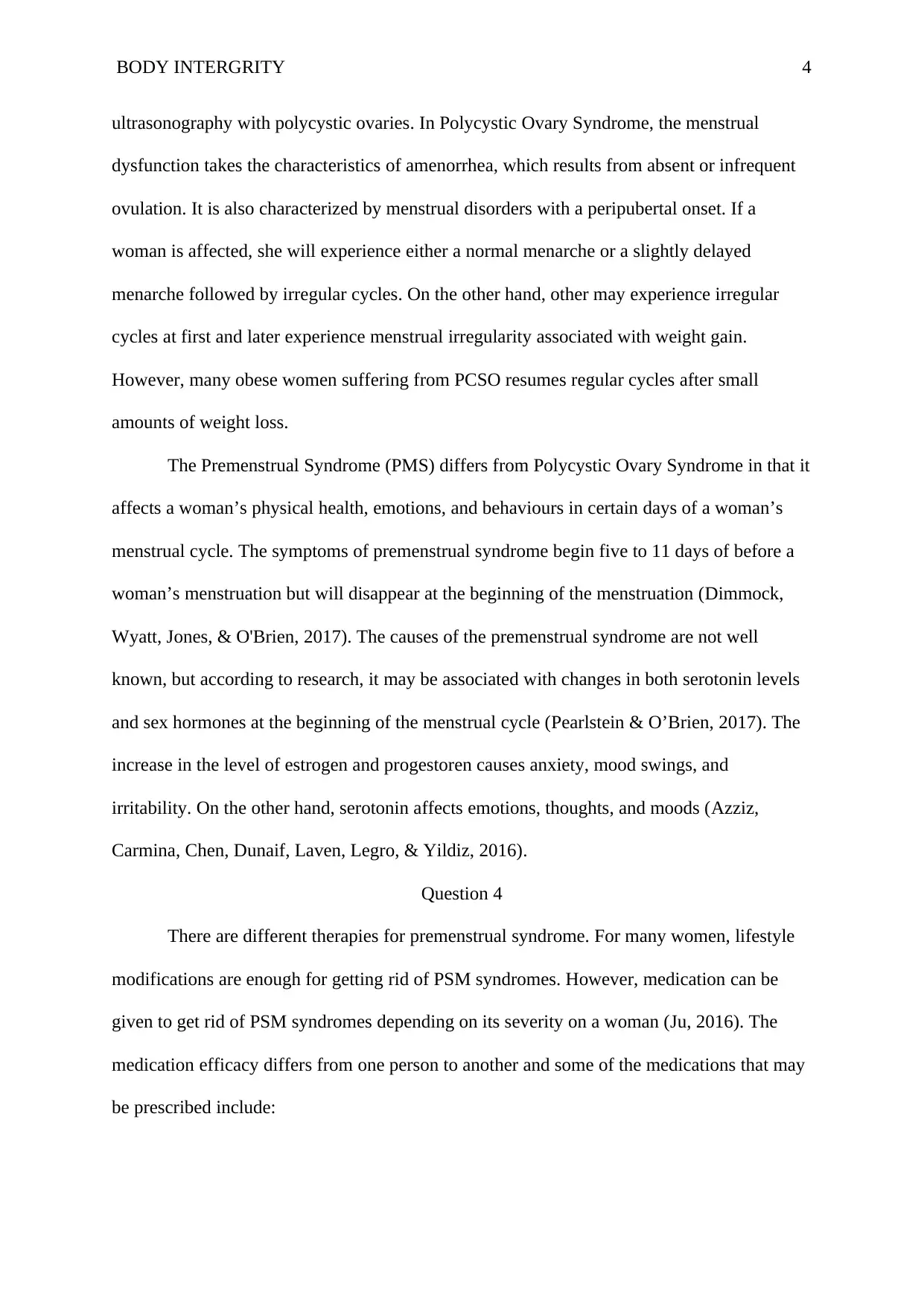
BODY INTERGRITY 4
ultrasonography with polycystic ovaries. In Polycystic Ovary Syndrome, the menstrual
dysfunction takes the characteristics of amenorrhea, which results from absent or infrequent
ovulation. It is also characterized by menstrual disorders with a peripubertal onset. If a
woman is affected, she will experience either a normal menarche or a slightly delayed
menarche followed by irregular cycles. On the other hand, other may experience irregular
cycles at first and later experience menstrual irregularity associated with weight gain.
However, many obese women suffering from PCSO resumes regular cycles after small
amounts of weight loss.
The Premenstrual Syndrome (PMS) differs from Polycystic Ovary Syndrome in that it
affects a woman’s physical health, emotions, and behaviours in certain days of a woman’s
menstrual cycle. The symptoms of premenstrual syndrome begin five to 11 days of before a
woman’s menstruation but will disappear at the beginning of the menstruation (Dimmock,
Wyatt, Jones, & O'Brien, 2017). The causes of the premenstrual syndrome are not well
known, but according to research, it may be associated with changes in both serotonin levels
and sex hormones at the beginning of the menstrual cycle (Pearlstein & O’Brien, 2017). The
increase in the level of estrogen and progestoren causes anxiety, mood swings, and
irritability. On the other hand, serotonin affects emotions, thoughts, and moods (Azziz,
Carmina, Chen, Dunaif, Laven, Legro, & Yildiz, 2016).
Question 4
There are different therapies for premenstrual syndrome. For many women, lifestyle
modifications are enough for getting rid of PSM syndromes. However, medication can be
given to get rid of PSM syndromes depending on its severity on a woman (Ju, 2016). The
medication efficacy differs from one person to another and some of the medications that may
be prescribed include:
ultrasonography with polycystic ovaries. In Polycystic Ovary Syndrome, the menstrual
dysfunction takes the characteristics of amenorrhea, which results from absent or infrequent
ovulation. It is also characterized by menstrual disorders with a peripubertal onset. If a
woman is affected, she will experience either a normal menarche or a slightly delayed
menarche followed by irregular cycles. On the other hand, other may experience irregular
cycles at first and later experience menstrual irregularity associated with weight gain.
However, many obese women suffering from PCSO resumes regular cycles after small
amounts of weight loss.
The Premenstrual Syndrome (PMS) differs from Polycystic Ovary Syndrome in that it
affects a woman’s physical health, emotions, and behaviours in certain days of a woman’s
menstrual cycle. The symptoms of premenstrual syndrome begin five to 11 days of before a
woman’s menstruation but will disappear at the beginning of the menstruation (Dimmock,
Wyatt, Jones, & O'Brien, 2017). The causes of the premenstrual syndrome are not well
known, but according to research, it may be associated with changes in both serotonin levels
and sex hormones at the beginning of the menstrual cycle (Pearlstein & O’Brien, 2017). The
increase in the level of estrogen and progestoren causes anxiety, mood swings, and
irritability. On the other hand, serotonin affects emotions, thoughts, and moods (Azziz,
Carmina, Chen, Dunaif, Laven, Legro, & Yildiz, 2016).
Question 4
There are different therapies for premenstrual syndrome. For many women, lifestyle
modifications are enough for getting rid of PSM syndromes. However, medication can be
given to get rid of PSM syndromes depending on its severity on a woman (Ju, 2016). The
medication efficacy differs from one person to another and some of the medications that may
be prescribed include:
Secure Best Marks with AI Grader
Need help grading? Try our AI Grader for instant feedback on your assignments.
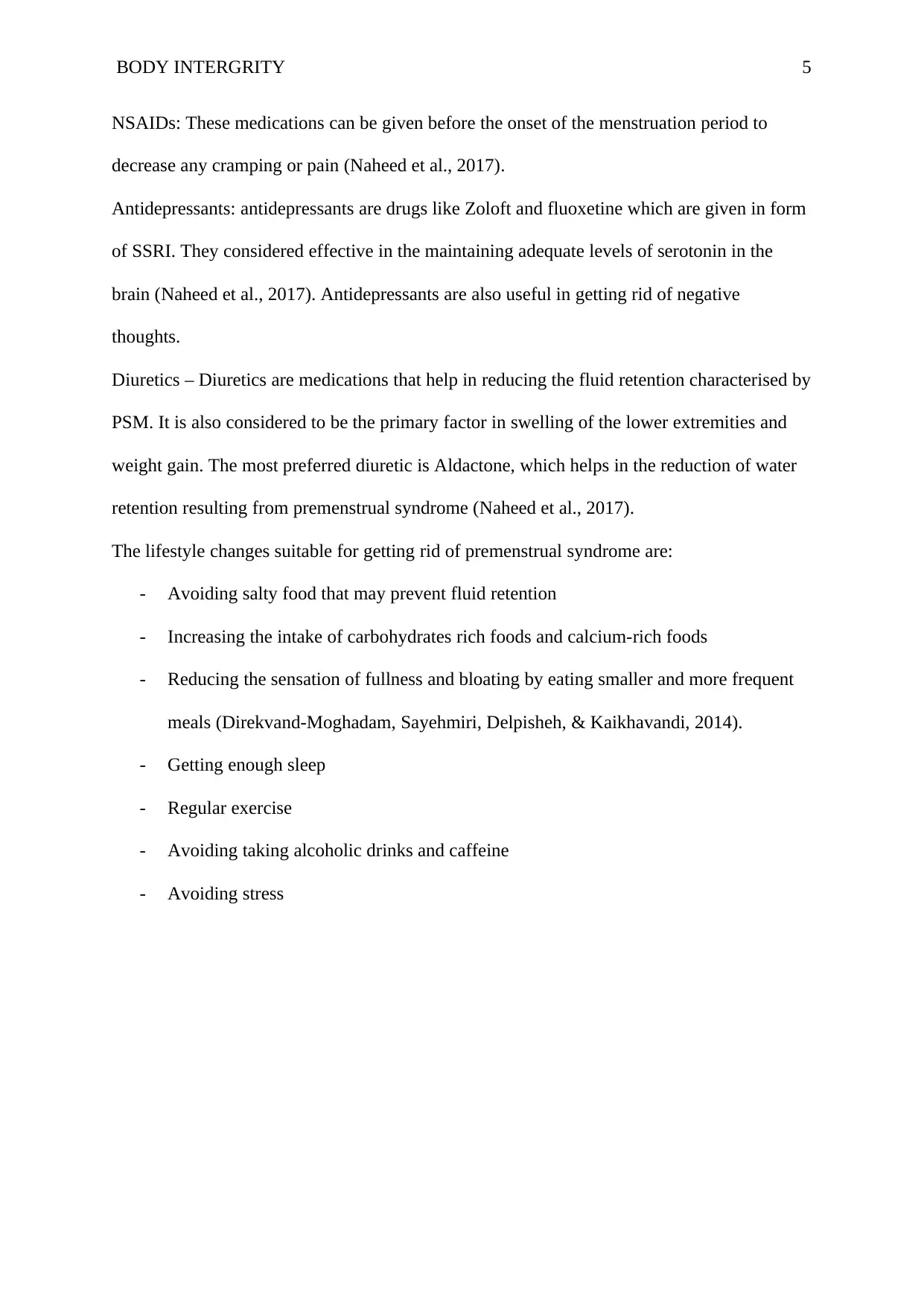
BODY INTERGRITY 5
NSAIDs: These medications can be given before the onset of the menstruation period to
decrease any cramping or pain (Naheed et al., 2017).
Antidepressants: antidepressants are drugs like Zoloft and fluoxetine which are given in form
of SSRI. They considered effective in the maintaining adequate levels of serotonin in the
brain (Naheed et al., 2017). Antidepressants are also useful in getting rid of negative
thoughts.
Diuretics – Diuretics are medications that help in reducing the fluid retention characterised by
PSM. It is also considered to be the primary factor in swelling of the lower extremities and
weight gain. The most preferred diuretic is Aldactone, which helps in the reduction of water
retention resulting from premenstrual syndrome (Naheed et al., 2017).
The lifestyle changes suitable for getting rid of premenstrual syndrome are:
- Avoiding salty food that may prevent fluid retention
- Increasing the intake of carbohydrates rich foods and calcium-rich foods
- Reducing the sensation of fullness and bloating by eating smaller and more frequent
meals (Direkvand-Moghadam, Sayehmiri, Delpisheh, & Kaikhavandi, 2014).
- Getting enough sleep
- Regular exercise
- Avoiding taking alcoholic drinks and caffeine
- Avoiding stress
NSAIDs: These medications can be given before the onset of the menstruation period to
decrease any cramping or pain (Naheed et al., 2017).
Antidepressants: antidepressants are drugs like Zoloft and fluoxetine which are given in form
of SSRI. They considered effective in the maintaining adequate levels of serotonin in the
brain (Naheed et al., 2017). Antidepressants are also useful in getting rid of negative
thoughts.
Diuretics – Diuretics are medications that help in reducing the fluid retention characterised by
PSM. It is also considered to be the primary factor in swelling of the lower extremities and
weight gain. The most preferred diuretic is Aldactone, which helps in the reduction of water
retention resulting from premenstrual syndrome (Naheed et al., 2017).
The lifestyle changes suitable for getting rid of premenstrual syndrome are:
- Avoiding salty food that may prevent fluid retention
- Increasing the intake of carbohydrates rich foods and calcium-rich foods
- Reducing the sensation of fullness and bloating by eating smaller and more frequent
meals (Direkvand-Moghadam, Sayehmiri, Delpisheh, & Kaikhavandi, 2014).
- Getting enough sleep
- Regular exercise
- Avoiding taking alcoholic drinks and caffeine
- Avoiding stress
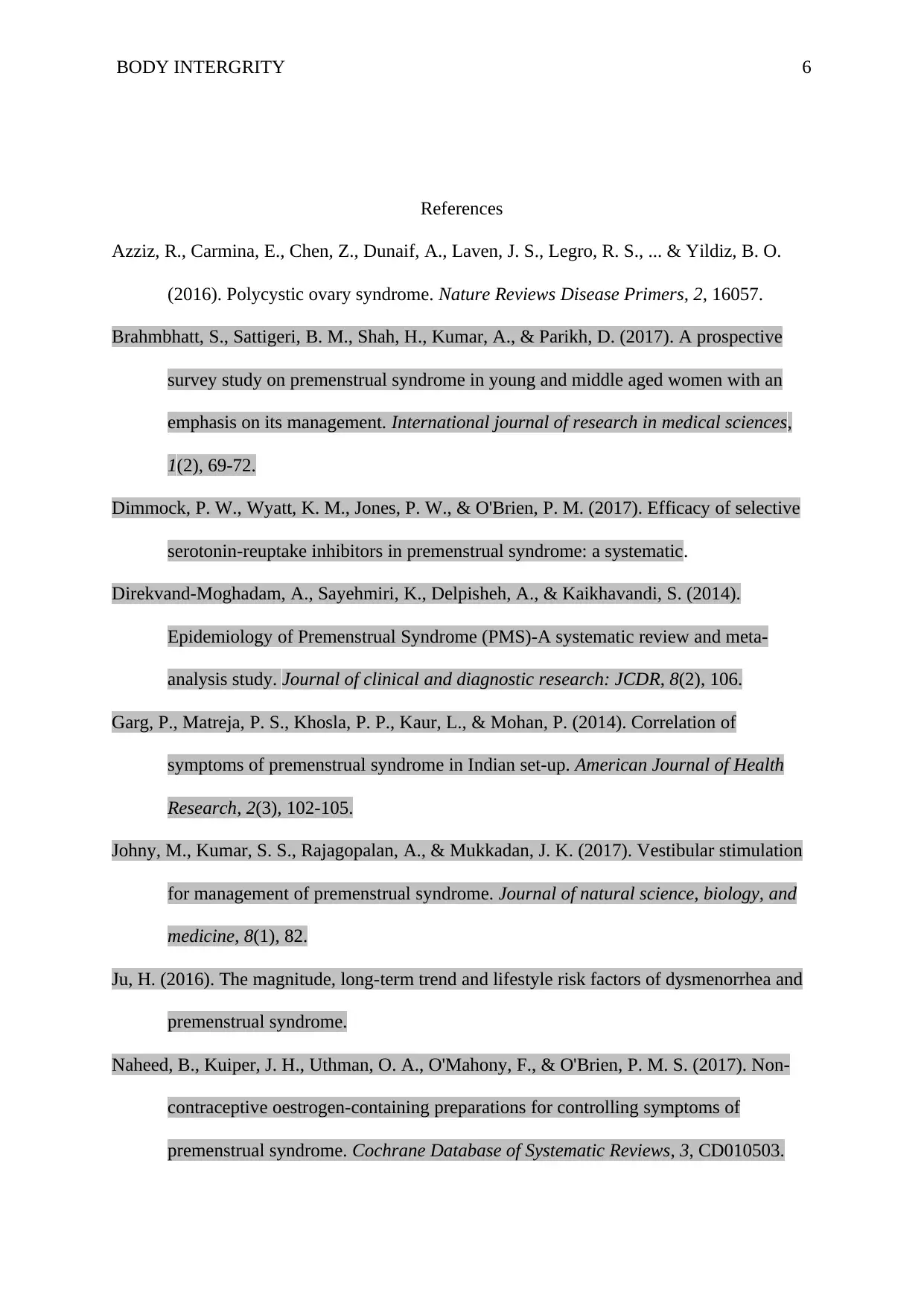
BODY INTERGRITY 6
References
Azziz, R., Carmina, E., Chen, Z., Dunaif, A., Laven, J. S., Legro, R. S., ... & Yildiz, B. O.
(2016). Polycystic ovary syndrome. Nature Reviews Disease Primers, 2, 16057.
Brahmbhatt, S., Sattigeri, B. M., Shah, H., Kumar, A., & Parikh, D. (2017). A prospective
survey study on premenstrual syndrome in young and middle aged women with an
emphasis on its management. International journal of research in medical sciences,
1(2), 69-72.
Dimmock, P. W., Wyatt, K. M., Jones, P. W., & O'Brien, P. M. (2017). Efficacy of selective
serotonin-reuptake inhibitors in premenstrual syndrome: a systematic.
Direkvand-Moghadam, A., Sayehmiri, K., Delpisheh, A., & Kaikhavandi, S. (2014).
Epidemiology of Premenstrual Syndrome (PMS)-A systematic review and meta-
analysis study. Journal of clinical and diagnostic research: JCDR, 8(2), 106.
Garg, P., Matreja, P. S., Khosla, P. P., Kaur, L., & Mohan, P. (2014). Correlation of
symptoms of premenstrual syndrome in Indian set-up. American Journal of Health
Research, 2(3), 102-105.
Johny, M., Kumar, S. S., Rajagopalan, A., & Mukkadan, J. K. (2017). Vestibular stimulation
for management of premenstrual syndrome. Journal of natural science, biology, and
medicine, 8(1), 82.
Ju, H. (2016). The magnitude, long-term trend and lifestyle risk factors of dysmenorrhea and
premenstrual syndrome.
Naheed, B., Kuiper, J. H., Uthman, O. A., O'Mahony, F., & O'Brien, P. M. S. (2017). Non-
contraceptive oestrogen-containing preparations for controlling symptoms of
premenstrual syndrome. Cochrane Database of Systematic Reviews, 3, CD010503.
References
Azziz, R., Carmina, E., Chen, Z., Dunaif, A., Laven, J. S., Legro, R. S., ... & Yildiz, B. O.
(2016). Polycystic ovary syndrome. Nature Reviews Disease Primers, 2, 16057.
Brahmbhatt, S., Sattigeri, B. M., Shah, H., Kumar, A., & Parikh, D. (2017). A prospective
survey study on premenstrual syndrome in young and middle aged women with an
emphasis on its management. International journal of research in medical sciences,
1(2), 69-72.
Dimmock, P. W., Wyatt, K. M., Jones, P. W., & O'Brien, P. M. (2017). Efficacy of selective
serotonin-reuptake inhibitors in premenstrual syndrome: a systematic.
Direkvand-Moghadam, A., Sayehmiri, K., Delpisheh, A., & Kaikhavandi, S. (2014).
Epidemiology of Premenstrual Syndrome (PMS)-A systematic review and meta-
analysis study. Journal of clinical and diagnostic research: JCDR, 8(2), 106.
Garg, P., Matreja, P. S., Khosla, P. P., Kaur, L., & Mohan, P. (2014). Correlation of
symptoms of premenstrual syndrome in Indian set-up. American Journal of Health
Research, 2(3), 102-105.
Johny, M., Kumar, S. S., Rajagopalan, A., & Mukkadan, J. K. (2017). Vestibular stimulation
for management of premenstrual syndrome. Journal of natural science, biology, and
medicine, 8(1), 82.
Ju, H. (2016). The magnitude, long-term trend and lifestyle risk factors of dysmenorrhea and
premenstrual syndrome.
Naheed, B., Kuiper, J. H., Uthman, O. A., O'Mahony, F., & O'Brien, P. M. S. (2017). Non-
contraceptive oestrogen-containing preparations for controlling symptoms of
premenstrual syndrome. Cochrane Database of Systematic Reviews, 3, CD010503.
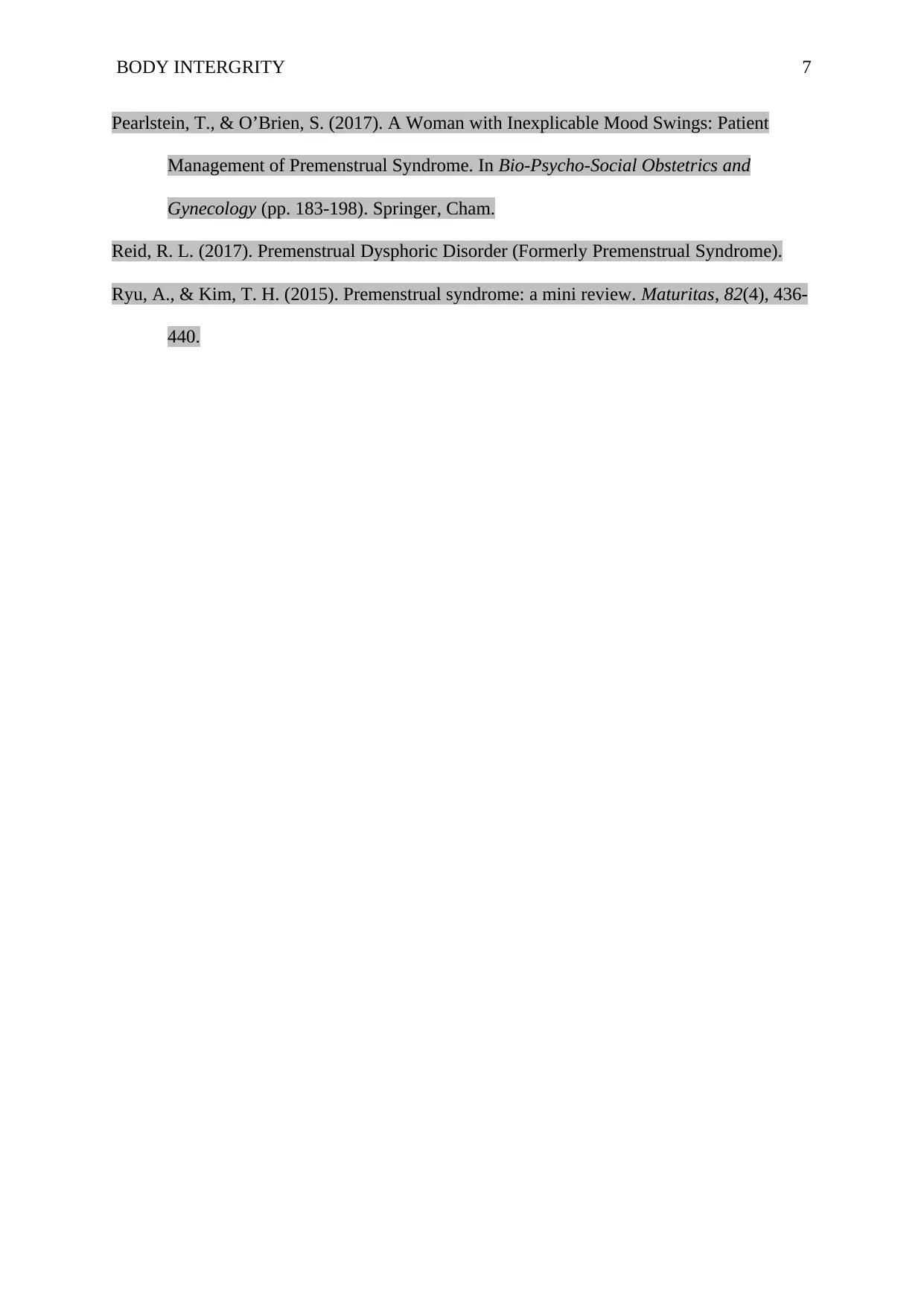
BODY INTERGRITY 7
Pearlstein, T., & O’Brien, S. (2017). A Woman with Inexplicable Mood Swings: Patient
Management of Premenstrual Syndrome. In Bio-Psycho-Social Obstetrics and
Gynecology (pp. 183-198). Springer, Cham.
Reid, R. L. (2017). Premenstrual Dysphoric Disorder (Formerly Premenstrual Syndrome).
Ryu, A., & Kim, T. H. (2015). Premenstrual syndrome: a mini review. Maturitas, 82(4), 436-
440.
Pearlstein, T., & O’Brien, S. (2017). A Woman with Inexplicable Mood Swings: Patient
Management of Premenstrual Syndrome. In Bio-Psycho-Social Obstetrics and
Gynecology (pp. 183-198). Springer, Cham.
Reid, R. L. (2017). Premenstrual Dysphoric Disorder (Formerly Premenstrual Syndrome).
Ryu, A., & Kim, T. H. (2015). Premenstrual syndrome: a mini review. Maturitas, 82(4), 436-
440.
1 out of 7
Related Documents
Your All-in-One AI-Powered Toolkit for Academic Success.
+13062052269
info@desklib.com
Available 24*7 on WhatsApp / Email
![[object Object]](/_next/static/media/star-bottom.7253800d.svg)
Unlock your academic potential
© 2024 | Zucol Services PVT LTD | All rights reserved.





